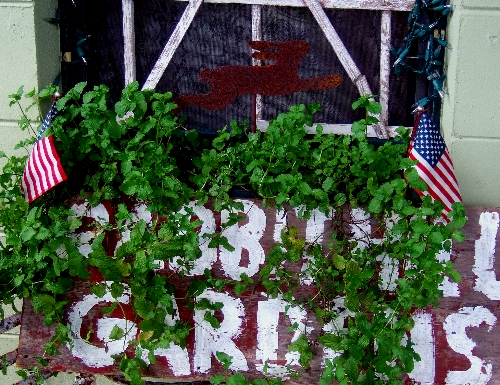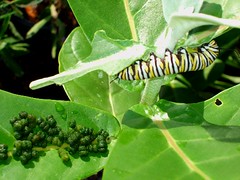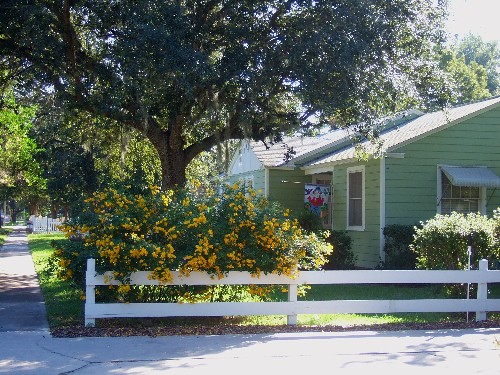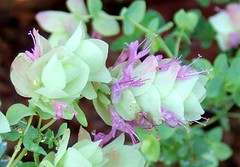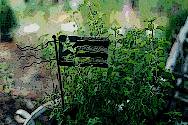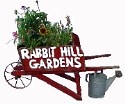Wednesday, July 05, 2017
Plants Currently in Stock as of July 5, 2017
We currently have no plants at either of our locations, Renningers Market or Eustis Fairgrounds but we are working toward having them again in the fall. In the meantime, see our vintage garden junque and herbal goodies at our outdoor booth at Renningers Flea Market in the field row 13 #10.
My Ten Favorite Summer Herbs
This is a reposting of a post made a few years ago but is still relevant at the beginning of this summer:
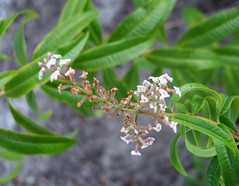
Lemon Verbena. Aloysia citriodora. The lemoniest of all the lemon herbs. This tropical shrub thrives in the summer producing lemon scented leaves that can be used as a tea or instead of lemon in salads and deserts. A good potpourri ingredient, too, and it was the favorite perfume of Scarlett O'Hara's mother.
Basil. Ocimum spp. What is summer without basil? Easy to grow and unsurpassed in the kitchen.
Patchouli. Pogostemon cablin. Loves our heat and humidity as long as you keep it shaded and well watered. Not a culinary herb, but widely used in the perfume industry and its scent will remind you baby boomers of the 60's.
Aloe. Aloe vera. Will tolerate drought but also thrives in our summer rainy season if given good drainage. Despite the fact that it looks like a desert plant, it will frequently bleach out under full sun, so try it in partial shade. A good plant to have around for healing burns and scrapes.
Garlic Chives. Allium tuberosum. A flat-leaved variety of chives that is nearly foolproof. Much easier to grow here than regular chives. Used as you would any chives, they add a subtle hint of garlic.
Culantro. Eryngium foetidum. If you love the flavor of cilantro (Coriandrum sativum) but are frustrated by even the "slow bolt" varieties quickly bolting in the heat, try culantro. It has nearly the exact flavor and will last throughout the summer. Spiny flower heads and spiny but soft leaves make this perennial an unusual looking addition to the garden.
Mexican Tarragon or Mexican Mint Marigold. Tagetes lucida. My favorite culinary herb. True French tarragon in impossibly difficult to grow here, but Mexican tarragon makes a very credible substitute and thrives in our hot, humid summers. Use in béarnaise sauce, tartar sauce, and on fish. Rewards you with pretty yellow flowers, too.
Cuban Oregano. Pletranthus amboinicus. The taste is similar to Greek oregano, but the leaves look nothing alike. Cuban oregano used to be classified as a coleus and, although fleshier, bears a resemblance to those plants including a number of colorful variegations. Give it plenty of room to spread.
Pineapple Sage. Salvia elegans. Most culinary sages struggle in the summer, but pineapple sage, like many ornamental sages, will thrive. It has pretty edible red flowers and leaves with a definite pineapple scent. Use in tea or as a garnish or simply enjoy its scent in the garden.
Lemongrass. Cymbopogon citratus. A nice tall clump of perennial grass with a light lemony flavor. The base of the blade makes a lovely tea and is often called for in Asian cooking.

Lemon Verbena. Aloysia citriodora. The lemoniest of all the lemon herbs. This tropical shrub thrives in the summer producing lemon scented leaves that can be used as a tea or instead of lemon in salads and deserts. A good potpourri ingredient, too, and it was the favorite perfume of Scarlett O'Hara's mother.
Basil. Ocimum spp. What is summer without basil? Easy to grow and unsurpassed in the kitchen.
Patchouli. Pogostemon cablin. Loves our heat and humidity as long as you keep it shaded and well watered. Not a culinary herb, but widely used in the perfume industry and its scent will remind you baby boomers of the 60's.
Aloe. Aloe vera. Will tolerate drought but also thrives in our summer rainy season if given good drainage. Despite the fact that it looks like a desert plant, it will frequently bleach out under full sun, so try it in partial shade. A good plant to have around for healing burns and scrapes.
Garlic Chives. Allium tuberosum. A flat-leaved variety of chives that is nearly foolproof. Much easier to grow here than regular chives. Used as you would any chives, they add a subtle hint of garlic.
Culantro. Eryngium foetidum. If you love the flavor of cilantro (Coriandrum sativum) but are frustrated by even the "slow bolt" varieties quickly bolting in the heat, try culantro. It has nearly the exact flavor and will last throughout the summer. Spiny flower heads and spiny but soft leaves make this perennial an unusual looking addition to the garden.
Mexican Tarragon or Mexican Mint Marigold. Tagetes lucida. My favorite culinary herb. True French tarragon in impossibly difficult to grow here, but Mexican tarragon makes a very credible substitute and thrives in our hot, humid summers. Use in béarnaise sauce, tartar sauce, and on fish. Rewards you with pretty yellow flowers, too.
Cuban Oregano. Pletranthus amboinicus. The taste is similar to Greek oregano, but the leaves look nothing alike. Cuban oregano used to be classified as a coleus and, although fleshier, bears a resemblance to those plants including a number of colorful variegations. Give it plenty of room to spread.
Pineapple Sage. Salvia elegans. Most culinary sages struggle in the summer, but pineapple sage, like many ornamental sages, will thrive. It has pretty edible red flowers and leaves with a definite pineapple scent. Use in tea or as a garnish or simply enjoy its scent in the garden.
Lemongrass. Cymbopogon citratus. A nice tall clump of perennial grass with a light lemony flavor. The base of the blade makes a lovely tea and is often called for in Asian cooking.
Wednesday, September 29, 2010
Herbal Recipe #1: Fresh Herbed Waffles
This is a great alternative to the usual sweet waffle and is particularly good for a luncheon menu. Recipe makes approximately six 7" waffles.
1 3/4 C. all-purpose flour
1/4 C. grated parmesan cheese
2 minced scallions using white parts and tender green parts
1/2 C. chopped fresh parsley
2 T. chopped fresh basil
2 T. chopped fresh rosemary
1 T. sugar
1 3/4 t. baking powder
1/2 t. baking soda
1 3/4 t. salt
1 1/3 C milk
2 lg eggs
3 T. melted butter
2 t. Dijon mustard
Sour cream
Preheat oven or toaster oven to 200 degrees. This will be used to keep waffles after they are taken from the waffle iron. Preheat waffle iron. Combine first 10 ingredients (the dry ingredients) in a medium bowl. Whisk together milk, eggs, butter and mustard (the moist ingredients) in another medium bowl. Pour the moist ingredients into the dry ingredients and stir until smooth.
Lightly spray or oil the waffle iron (spraying is MUCH easier on the bumpy waffle iron surface). Follow your waffle maker's instructions or pour about 1/3 cup of batter onto the grid and spread it until it nearly touches the corners. Close and cook for 2 to 3 minutes or until golden brown. The waffle should release easily from the waffle iron and the edges should be dry. Place cooked waffles in the oven to keep them crisp while making remaining waffles. You may want to adjust the amount of batter used for the remaining waffles if batter oozed out of iron or if waffles are too small. Continue spraying and pouring until all batter is used up.
Serve waffles with a dollop of sour cream. You can use these waffles as a main dish or as a side to say chicken or tuna salad. They can be made ahead and frozen, then reheated in oven or toaster oven. Avoid reheating waffles in a microwave as this will make them "gummy".
1 3/4 C. all-purpose flour
1/4 C. grated parmesan cheese
2 minced scallions using white parts and tender green parts
1/2 C. chopped fresh parsley
2 T. chopped fresh basil
2 T. chopped fresh rosemary
1 T. sugar
1 3/4 t. baking powder
1/2 t. baking soda
1 3/4 t. salt
1 1/3 C milk
2 lg eggs
3 T. melted butter
2 t. Dijon mustard
Sour cream
Preheat oven or toaster oven to 200 degrees. This will be used to keep waffles after they are taken from the waffle iron. Preheat waffle iron. Combine first 10 ingredients (the dry ingredients) in a medium bowl. Whisk together milk, eggs, butter and mustard (the moist ingredients) in another medium bowl. Pour the moist ingredients into the dry ingredients and stir until smooth.
Lightly spray or oil the waffle iron (spraying is MUCH easier on the bumpy waffle iron surface). Follow your waffle maker's instructions or pour about 1/3 cup of batter onto the grid and spread it until it nearly touches the corners. Close and cook for 2 to 3 minutes or until golden brown. The waffle should release easily from the waffle iron and the edges should be dry. Place cooked waffles in the oven to keep them crisp while making remaining waffles. You may want to adjust the amount of batter used for the remaining waffles if batter oozed out of iron or if waffles are too small. Continue spraying and pouring until all batter is used up.
Serve waffles with a dollop of sour cream. You can use these waffles as a main dish or as a side to say chicken or tuna salad. They can be made ahead and frozen, then reheated in oven or toaster oven. Avoid reheating waffles in a microwave as this will make them "gummy".
Thursday, June 10, 2010
Florida Herb Societies
Belonging to an herb society is a good way to learn about herbs. Herb enthusiasts are great people and love to share their knowledge. Meetings are fun and often involve eating wonderful food!! Many have newsletters full of good information including tips on growing herbs in our challenging climate. Check out one of these herb groups near you (listed north to south with two regional organizations at the end):
Jacksonville Herb Society
Contact: Scott Stover, President
(904) 945-8965
Email: stovershop@comcast.net
Meets 10:30 am the third Saturday of every month at
Glynlea Grace United Methodist Church
6429 Atlantic Boulevard in Jacksonville.
Updated 1/10/08
The Herbal Link
Contact: Loretta Inman
(904) 382-8080
Email: lori_inman@bellsouth.net
Tallahassee Herb Society
Contact: Kay Fausel, President
or Alice Cappa, Newsletter Editor
(850) 997-5505 (Alice Cappa)
Email: acappa@att.net
Meets 7:00 pm the second Wednesday of every month
at various locations.
North Central Florida Herb Society
Contact: Barbara Bennett
(352) 372-4981
Meets 7:00 pm the third Tuesday of every month
except during the summer
at the downtown library on East University in Gainesville.
Deland Herb Society
Contact: Karen Hall, President
(386) 736-1839
Meets the first Thursday of every month September - May
at the Garden Club of Deland
Seaside Herb Society
Contact: Kathy Kosak, President
12 San Jose Circle
Ormond Beach, FL 32176
(386) 441-3382
Email: nrkosak1@bellsouth.net
Meets 9:30 am the third Saturday of every month
at Riverbend Community Church, Beach and Granada Streets
in Ormond Beach.
For more information: http://dir.gardennet.com
Updated 1/10/08
Thyme on Our Hands (Spruce Creek)
Contact: Nelda Ewald
2882 Grumman Court
Daytona Beach, FL 32128
(386) 760-4235
Email: flyer12941@aol.com
Meets the third Friday of every month
at various members' homes.
Herb Society of Central Florida
Contact: Emily Ruff, President
PO Box 11183
Orlando, FL 32803
(407) 595-3731
Email: orlandoherbs@gmail.com
Meets 7:00 pm the second* Monday of every month
at Leu Gardens in Orlando.
*Note: meetings were changed from first to second Monday starting Sept 2008
Updated 9/24/08
Hernando Herb Society
Contact: Mary Repper, President
(352) 799-5717
Email: maryrepper@aol.com
Meets the fourth Monday of every month September - May
at the Hernando Extension Office in Brooksville.
Updated 1/11/08
Florida Herb Society
Contact: membership@floridaherbsociety.org
Emily Wenzel emily@floridaherbsociety.org (727) 365-8574 or
Yetta Jaworski yetta@floridaherbsociety.org (727) 517-8970
Meets 6:30 pm (herb swap) / 7:00 pm (meeting)
the third Tuesday of every month September - June
at the Clearwater Garden Club 405 Seminole St in Clearwater.
For more information check out their very informative website: www.floridaherbsociety.org
Updated 6/10/10
Manatee Herb Society
Contact: Sue Moury, President
(941) 795-8828
Email: BrendaJohson@msn.com
Meets the third Wednesday of every month except July and August
alternating evenings and afternoons at the public library
1301 Barcarrota Boulevard in Bradenton.
Updated 9/23/04
The Vero Beach Herbal Society
Contact: Julie McCusker, President
PO Box 262
Winter Beach, FL 32971
(772) 778-9328 Greens & Things
Meets 7:30 pm the second Tuesday of every month
at the Vero Beach Community Center.
Heathcote Herb Society
Contact: Linda LeMieux, President
(772) 464-4672 Heathcote Botanical Gardens
Email through Heathcote Botanical Gardens: hbg@ircc.net
Meets at Heathcote Botanical Gardens in Fort Pierce
Updated 10/26/04
Herb Society of Palm Beach County
Contact: Linda Spillane, President
or Edith Peekin (561) 640-7943
Write: c/o Mounts Botanical Garden
531 N. Military Trail
West Palm Beach, FL 33415
Meets 10:00 am the second Tuesday of every month except July and August
at Mounts Botanical Garden in West Palm Beach
For more information: http://dir.gardennet.com/
Evening Herb Society of the Palm Beaches
PO Box 17318
West Palm Beach, FL 33416
Voicemail: (561) 835-6724
Email: talk2EHS@gopbi.com
Meets 7:30 pm the last Tuesday of every month
at Mounts Botanical Garden in West Palm Beach
For more information: http://communitylink.gopbi.com/
Updated 1/10/08
Broward County Herb and Spice Society
Contact: Sharon Sootin
(954) 921-5111
Email: mudanacher@aol.com
Meets 7:30 pm the fourth Monday of every month
at the Broward County Extension Education Division,
3245 College Ave in Davie
Updated 1/10/08
Redland Evening Herb Society
Contact: Leila Barnes
(305) 245-3367
Email through Fruit and Spice Park: fsp@miamidade.gov
Meets 7:30 pm the first Wednesday of every month
at Fruit and Spice Park in Homestead
A great informative website: http://www.rehsonline.com/
Updated 2/28/06
Herb Society of America Southeast District (Includes Florida)
Contact: Helen Phillips
13580 Highway 27
Hamilton, GA 31811
(706) 628-0075
Email: hkphillips@earthlink.net
Members-at-large meet annually.
For more information: http://www.herbsociety.org/
International Herb Association Southeast Regional Chapter (Includes Florida)
Contact: Marge Powell
PO Box 5667
Jacksonville, FL 32247
(904) 399-3241
Email: margepowel@aol.com
For more information: http://www.iherb.org/
Updated 5/18/04
Do you know of another herb society in Florida? Is there an error, an email address no longer valid or an update needed in any of the above listings? Please let us know in the comments or at rhgherbfarm@yahoo.com .
Jacksonville Herb Society
Contact: Scott Stover, President
(904) 945-8965
Email: stovershop@comcast.net
Meets 10:30 am the third Saturday of every month at
Glynlea Grace United Methodist Church
6429 Atlantic Boulevard in Jacksonville.
Updated 1/10/08
The Herbal Link
Contact: Loretta Inman
(904) 382-8080
Email: lori_inman@bellsouth.net
Tallahassee Herb Society
Contact: Kay Fausel, President
or Alice Cappa, Newsletter Editor
(850) 997-5505 (Alice Cappa)
Email: acappa@att.net
Meets 7:00 pm the second Wednesday of every month
at various locations.
North Central Florida Herb Society
Contact: Barbara Bennett
(352) 372-4981
Meets 7:00 pm the third Tuesday of every month
except during the summer
at the downtown library on East University in Gainesville.
Deland Herb Society
Contact: Karen Hall, President
(386) 736-1839
Meets the first Thursday of every month September - May
at the Garden Club of Deland
Seaside Herb Society
Contact: Kathy Kosak, President
12 San Jose Circle
Ormond Beach, FL 32176
(386) 441-3382
Email: nrkosak1@bellsouth.net
Meets 9:30 am the third Saturday of every month
at Riverbend Community Church, Beach and Granada Streets
in Ormond Beach.
For more information: http://dir.gardennet.com
Updated 1/10/08
Thyme on Our Hands (Spruce Creek)
Contact: Nelda Ewald
2882 Grumman Court
Daytona Beach, FL 32128
(386) 760-4235
Email: flyer12941@aol.com
Meets the third Friday of every month
at various members' homes.
Herb Society of Central Florida
Contact: Emily Ruff, President
PO Box 11183
Orlando, FL 32803
(407) 595-3731
Email: orlandoherbs@gmail.com
Meets 7:00 pm the second* Monday of every month
at Leu Gardens in Orlando.
*Note: meetings were changed from first to second Monday starting Sept 2008
Updated 9/24/08
Hernando Herb Society
Contact: Mary Repper, President
(352) 799-5717
Email: maryrepper@aol.com
Meets the fourth Monday of every month September - May
at the Hernando Extension Office in Brooksville.
Updated 1/11/08
Florida Herb Society
Contact: membership@floridaherbsociety.org
Emily Wenzel emily@floridaherbsociety.org (727) 365-8574 or
Yetta Jaworski yetta@floridaherbsociety.org (727) 517-8970
Meets 6:30 pm (herb swap) / 7:00 pm (meeting)
the third Tuesday of every month September - June
at the Clearwater Garden Club 405 Seminole St in Clearwater.
For more information check out their very informative website: www.floridaherbsociety.org
Updated 6/10/10
Manatee Herb Society
Contact: Sue Moury, President
(941) 795-8828
Email: BrendaJohson@msn.com
Meets the third Wednesday of every month except July and August
alternating evenings and afternoons at the public library
1301 Barcarrota Boulevard in Bradenton.
Updated 9/23/04
The Vero Beach Herbal Society
Contact: Julie McCusker, President
PO Box 262
Winter Beach, FL 32971
(772) 778-9328 Greens & Things
Meets 7:30 pm the second Tuesday of every month
at the Vero Beach Community Center.
Heathcote Herb Society
Contact: Linda LeMieux, President
(772) 464-4672 Heathcote Botanical Gardens
Email through Heathcote Botanical Gardens: hbg@ircc.net
Meets at Heathcote Botanical Gardens in Fort Pierce
Updated 10/26/04
Herb Society of Palm Beach County
Contact: Linda Spillane, President
or Edith Peekin (561) 640-7943
Write: c/o Mounts Botanical Garden
531 N. Military Trail
West Palm Beach, FL 33415
Meets 10:00 am the second Tuesday of every month except July and August
at Mounts Botanical Garden in West Palm Beach
For more information: http://dir.gardennet.com/
Evening Herb Society of the Palm Beaches
PO Box 17318
West Palm Beach, FL 33416
Voicemail: (561) 835-6724
Email: talk2EHS@gopbi.com
Meets 7:30 pm the last Tuesday of every month
at Mounts Botanical Garden in West Palm Beach
For more information: http://communitylink.gopbi.com/
Updated 1/10/08
Broward County Herb and Spice Society
Contact: Sharon Sootin
(954) 921-5111
Email: mudanacher@aol.com
Meets 7:30 pm the fourth Monday of every month
at the Broward County Extension Education Division,
3245 College Ave in Davie
Updated 1/10/08
Redland Evening Herb Society
Contact: Leila Barnes
(305) 245-3367
Email through Fruit and Spice Park: fsp@miamidade.gov
Meets 7:30 pm the first Wednesday of every month
at Fruit and Spice Park in Homestead
A great informative website: http://www.rehsonline.com/
Updated 2/28/06
Herb Society of America Southeast District (Includes Florida)
Contact: Helen Phillips
13580 Highway 27
Hamilton, GA 31811
(706) 628-0075
Email: hkphillips@earthlink.net
Members-at-large meet annually.
For more information: http://www.herbsociety.org/
International Herb Association Southeast Regional Chapter (Includes Florida)
Contact: Marge Powell
PO Box 5667
Jacksonville, FL 32247
(904) 399-3241
Email: margepowel@aol.com
For more information: http://www.iherb.org/
Updated 5/18/04
Do you know of another herb society in Florida? Is there an error, an email address no longer valid or an update needed in any of the above listings? Please let us know in the comments or at rhgherbfarm@yahoo.com .
Monday, January 04, 2010
Maggie
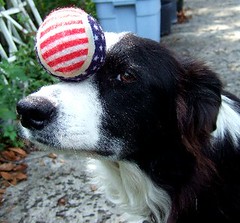
To all of my customers who have been asking after Maggie, the border collie greeter at my old location, I'm sad to report that she died between Christmas and New Years. Maggie had a good life, was much loved and lived to be over 100 in dog years.
Her favorite things:
1. Frisbees
2. Swimming
3. Swimming after Frisbees thrown into the lake
4. Playing hide and seek
5. Frisbees
6. Trying to catch the water from the garden hose
7. Really loud squeeky toys
8. Waiting for the dog to bark at the end of the Mclaughlin Group. (That dog was saying something to her!)
9. Did I mention Frisbees?
R.I.P. Maggie my BDFF.
Tuesday, November 03, 2009
Herbal Flowers #7

Pictured above are nasturtiums, Tropaeolum majus, one of my favorite herbs. The flowers are not only beautiful in the garden, but are one of the best edible flowers around.
A member of the Cruciferae (mustard) family, nasturtium has leaves and flowers with a great cress-like peppery taste from benzyl isothiocyanate, a form of mustard oil. High in vitamin C, the leaves as well as the flowers make a great addition to a salad of mixed greens. I have also made a delicious pesto using half nasturtium leaves and half parsley instead of the usual basil.
Now is the time of year to start growing nasturtiums here in Florida as they deteriorate in the intense heat of our summers. They also dislike extreme cold, so take care to protect them or bring them in when the temperature dips into the 30s. They're easy to grow, preferring full sun and very little fertilizer in order to flower. (Too much fertilizer will give you lots of leaves with little flowering.) Nasturtiums come in mounding and vining forms, several flower colors and a variety with variegated leaves.
Thursday, March 19, 2009
Thursday, December 25, 2008
Friday, October 31, 2008
Five Things I Learned About Dogs Last Saturday Night
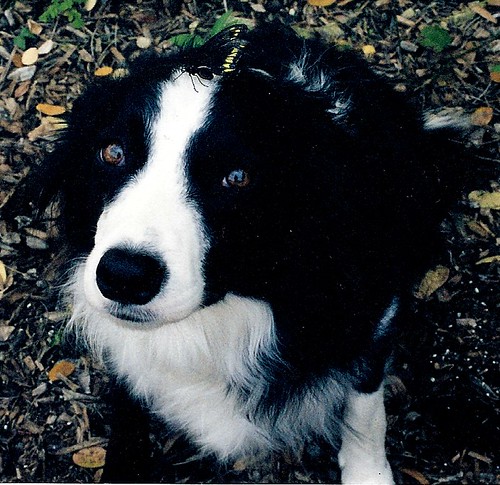
Maggie with a butterfly on her head
Five things I learned about dogs last Saturday night:
1. It’s surprisingly easy to forget that grapes are toxic to dogs until 2 seconds after yours has eaten the last bite of the leftover chicken salad Veronique you shouldn’t have given her.
2. According to various sites on the internet and the doctor answering the phone at the emergency veterinary clinic, hydrogen peroxide is the accepted method of inducing vomiting in dogs.
3. It’s easy to get the first teaspoon of hydrogen peroxide down a dog’s throat. The next few teaspoons, not so much.
4. About 20 minutes after swallowing a ¼ cup of hydrogen peroxide, a dog will expel all its previously eaten dinner along with an amazingly sticky mass of foaming goo.
5. Dogs are very quick to forgive.
Tuesday, August 12, 2008
In the Butterfy Garden: Caterpillar Predators
Customers often tell me that caterpillars they've been watching have suddenly disappeared and they wonder what could have happened to them. Sometimes they've just grown up and have gone off to pupate. But often they have become a victim of predators. Birds, of course, love a nice tasty caterpillar, but many smaller critters are predators as well. I recently captured two such predators with my camera.
This is a paper wasp devouring a monarch caterpillar. . . .
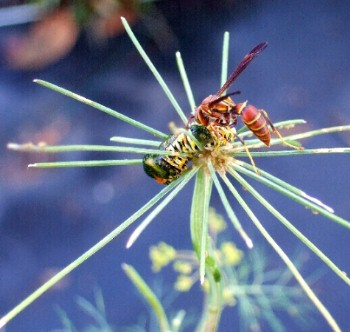
And this is what's left of a monarch caterpillar after a wasp is through with it:
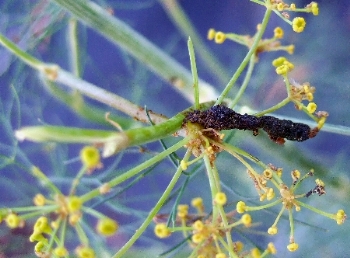
Lizards (or anoles as most of our lizards are appropriately called) eat butterfly eggs and caterpillars. Here is a lizard with an adult butterfly. It was at the end of it's life and was struggling on the sidewalk. I could see the lizard eyeing it and then grab it. It was a pretty heavy load for the lizard so I had time to run get my camera and snap this picture just before the poor butterfly was carried into the brush:
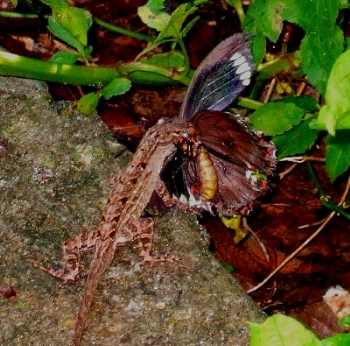
This is a paper wasp devouring a monarch caterpillar. . . .

And this is what's left of a monarch caterpillar after a wasp is through with it:

Lizards (or anoles as most of our lizards are appropriately called) eat butterfly eggs and caterpillars. Here is a lizard with an adult butterfly. It was at the end of it's life and was struggling on the sidewalk. I could see the lizard eyeing it and then grab it. It was a pretty heavy load for the lizard so I had time to run get my camera and snap this picture just before the poor butterfly was carried into the brush:

Friday, July 04, 2008
Friday, June 13, 2008
Saturday, February 16, 2008
The Old Florida Flame Vines
Thursday, February 07, 2008
Early February Butterfly Count

Red admiral on bright pink pentas
Throughout the winter I have been seeing lots of monarchs and zebra longwings, the occasional sulphur and not much else. But suddenly yesterday I saw so many butterflies appearing for the first time this year. A quick species count from the past 3 days:
blue cassius
red admiral
yellow sulphur
monarch
zebra longwing
gulf fritillary
gold rim swallowtail
Sunday, February 03, 2008
"I think using fresh herbs makes you more adventuresome in the kitchen."
Rabbit Hill Gardens and I are mentioned and quoted by Tom MacCubbin in two articles on herbs in today's Orlando Sentinel. Thanks Tom. One mistake in one article, however: it is culantro not cilantro that does well in the summer. Cilantro is a cool-weather annual like dill that bolts quickly and wilts in the heat. Culantro is a warm weather perennial that thrives in the heat and has a very similar taste.
Saturday, January 26, 2008
In the Butterfly Garden: Another Milkweed

Several years ago I started seeing growers selling giant milkweed (Calotropis gigantea) at butterfly gardening festivals. These were large plants in 3 gallon pots that sold in the neighborhood of $25. Though I had not seen any with monarch caterpillars, I was assured the giant milkweek was a good host plant. After seeing them several times, I finally broke down, purchased one and started taking cuttings. My hope was to be able to offer smaller plants at a lower price. They are not the easiest thing to propagate, but I have several going and sell them in a 1 gallon pot for $9.99.
Giant milkweed gets to be a large plant several feet high and would be great in ground here in central Florida except that our winter weather is a bit too cold. Calotropis is recommended for US zones 10B-11. We are 9B. My recommendation is to grow it in a large container and bring indoors when the temperature dips into the 30s.
The leaves of giant milkweed are large and a silvery green. The flowers come in lavender or white, though I only have the lavender. I've had plenty of flowers, but have yet to get any seed pods.
So the big question for butterfly gardeners is are they good host plants? Answer:
I've had lots of healthy monarch caterpillars on my giant milkweeds. And, as you can see, the large leaves give them more to eat than regular milkweed and also make a nice platform for collecting caterpillar poop.
Tuesday, November 06, 2007
In the Butterfly Garden: Two Plants with Fall Color
Among the best plants for fall color are two that are also great plants for the butterfly garden.
The first is Senna bicapsularis (syn. Cassia bicapsularis) with the common names of Christmas senna, winter cassia and fall cassia, all indicating that this is the time of year when they are at their peak of blooming. Fall cassia can be kept pruned into a tall shrub or can be let loose to form a small tree (10-12 feet). Right down the street from me on 11th Avenue in Mount Dora are a couple of fall cassias that have been planted to beautiful effect behind a white fence:

The first is Senna bicapsularis (syn. Cassia bicapsularis) with the common names of Christmas senna, winter cassia and fall cassia, all indicating that this is the time of year when they are at their peak of blooming. Fall cassia can be kept pruned into a tall shrub or can be let loose to form a small tree (10-12 feet). Right down the street from me on 11th Avenue in Mount Dora are a couple of fall cassias that have been planted to beautiful effect behind a white fence:
Fall cassia is a host plant for a number of sulphur butterfly caterpillars. These butterflies usually zoom through the yard without stopping, but will stop to lay eggs and perhaps stick around for a bit of nectar from one of your nectar plants. Pictured is a female sulphur laying an egg:
The second plant with great fall color is our native firebush (Hamelia patens) with its orange flowers and black berries. Firebush gets to be a tall shrub and can be grown in either full sun or partial shade. It is a favorite nectar plant of the two passionvine butterflies in our area: the gulf fritillary and the zebra longwing.

Thursday, September 06, 2007
Mislabeled
I was starting some nasturtium seeds today and saw on one of the packages something that reminds me how often garden things are mislabeled for Florida.
Many seed packages have a little map on the back and a chart that shows which months the seeds should be started in each area. For nasturtiums, which do best in cool weather, the package from American Seeds had it right: start seeds here Sept-Feb. This way they will be growing in the cool fall, winter and early spring and will only have to be protected on those few nights when temperatures approach freezing. But the Northrup-King seed package had it exactly backwards: start seeds here Feb-Sept. Obviously they were following the first frost dates for the northern zones and continued it for the most southern. But that would have us growing nasturtiums in late spring and summer when they will struggle in the heat.
I'm constantly running across things I think are mislabeled, especially mislabeled for Florida and I will try to post more as I run across them.
Many seed packages have a little map on the back and a chart that shows which months the seeds should be started in each area. For nasturtiums, which do best in cool weather, the package from American Seeds had it right: start seeds here Sept-Feb. This way they will be growing in the cool fall, winter and early spring and will only have to be protected on those few nights when temperatures approach freezing. But the Northrup-King seed package had it exactly backwards: start seeds here Feb-Sept. Obviously they were following the first frost dates for the northern zones and continued it for the most southern. But that would have us growing nasturtiums in late spring and summer when they will struggle in the heat.
I'm constantly running across things I think are mislabeled, especially mislabeled for Florida and I will try to post more as I run across them.
Saturday, August 25, 2007
Herbal Flowers #6
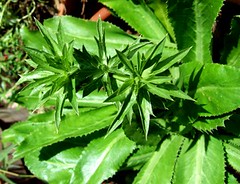
Earlier in this Herb Flowers series, I showed pictures of cilantro flowers. The spiky green flowers above are from a cilantro-flavored herb called culantro (Eryngium foetidum). Culantro is native to Mexico and Central and South America where it is widely used. It is great for Florida where cilantro is quick to bolt and is extremely difficult to grow in the summer garden. While cilantro is a cool weather annual, culantro is a warm weather perennial. It will grow here all year round, but needs to be protected if the temperature dips into the 30's. Grow in partial shade; it will take the heat of our summers but not in full sun.
Culantro is a low growing plant with flower spikes that have a conical flower head surrounded by spiky leaves that can be quite prickly to the touch. The lower basal leaves have a saw-toothed edge, but are soft and edible. They are the part used in culinary applications and can be used wherever cilantro is called for. Remove the flower spikes to encourage more basal leaf growth.
Thursday, July 12, 2007
Thank you Lady Bird Johnson
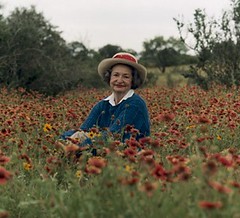
Picture in public domain available from Johnson Library.
Thank you Lady Bird Johnson for making this country a more beautiful place. In 1998, before I opened Rabbit Hill Gardens, I went to an Herb Growing & Marketing Network conference in San Antonio which offered a bus tour that included the famed Frederickberg Herb Farm and the Lady Bird Johnson Wildflower Center. The tour through her beloved Texas Hill Country was definitely the best part of a great conference. Rest in peace Lady Bird.
Sunday, July 08, 2007
Herbal Flowers #5
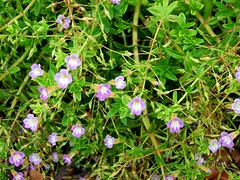
These cute little purple and white flowers belong to rice paddy herb (Limnophila aromatica) one of my favorite smelling herbs. Easily recognized by those familiar with Vietnamese cooking, it is unfamiliar to most of my customers. The scent is quite powerful, nearly identical to cumin, and I'm hoping to find a good recipe utilizing it. Anyone?
As the name indicates, it is native to southern Asia and grows in very wet areas. It is rated for zone 10. I was struck with the similarity between this herb and the water hyssops in our butterfly garden: similar flowers, long succulent stems, similar succulent leaves and watery habitat. Sure enough, they are in the same plant family, Plantaginaceae.
Saturday, July 07, 2007
Looking for photos of roadside gardens
Sissy Willis calls it "when plants garden". You know, roadside wildflowers that pop up without being planted. Fred First is looking for pictures for his online gallery Unplanted Gardens: America's Roadside Bloomery. Go there to see a beautiful example and how to submit your own photos. And look around Fred's site for more gorgeous photos from the Blue Ridge Mountains.
Friday, July 06, 2007
Wednesday, July 04, 2007
In the Butterfly Garden: Everyone Loves Milkweed!
The one plant that is the first to be planted in just about every butterfly garden is milkweed (Asclepias spp.). A host plant for the monarch and queen, it's also a decent nectar plant for a wide variety of butterflies. But move over, monarch caterpillar (below), there are other insects taking up residence in the milkweeds.

Aphids are a nearly constant presence on the tender ends. Normally the best control for aphids would be a spray like insecticidal soap, but in the butterfly garden I advise removing them with the garden hose. Luckily the aphids come off easily while the monarch eggs are sticky and not so easily dislodged. Unfortunately the aphids usually come back, so this can wind up being a daily process. Ladybugs will eat aphids so if you can attract them and keep them around, this can help too.
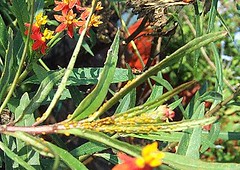
The other insects that enjoy milkweed are milkweed seed bugs. These orange and black bugs feed on the milkweed seeds. In the picture below, there is an adult in the upper right corner and lots of young nymphs on the milkweed seed pod. Usually there are only a few to be found and they can be picked off by hand. Occasionally, however, the population gets out of hand. You can try keeping the seed pods removed; otherwise spraying with insecticidal soap may be your only recourse.
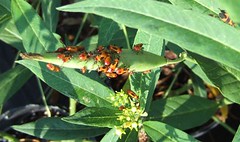

Aphids are a nearly constant presence on the tender ends. Normally the best control for aphids would be a spray like insecticidal soap, but in the butterfly garden I advise removing them with the garden hose. Luckily the aphids come off easily while the monarch eggs are sticky and not so easily dislodged. Unfortunately the aphids usually come back, so this can wind up being a daily process. Ladybugs will eat aphids so if you can attract them and keep them around, this can help too.

The other insects that enjoy milkweed are milkweed seed bugs. These orange and black bugs feed on the milkweed seeds. In the picture below, there is an adult in the upper right corner and lots of young nymphs on the milkweed seed pod. Usually there are only a few to be found and they can be picked off by hand. Occasionally, however, the population gets out of hand. You can try keeping the seed pods removed; otherwise spraying with insecticidal soap may be your only recourse.

Tuesday, July 03, 2007
Herbal Flowers #3
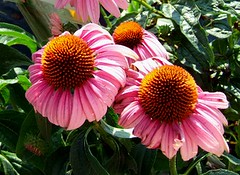
Echinacea spp. or purple coneflower produces beautiful flowers for any garden including the herb garden and butterfly garden. Native to the Midwest prairies, its medicinal roots were first used by native American Indians and it is considered today a major herbal immuno-stimulant. Butterflies love it as a nectar plant.
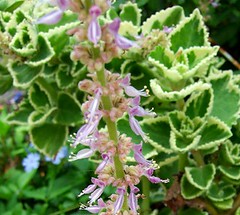
Besides the many species of true oreganos (Oreganums) there are a number of other oregano tasting plants which use the common name oregano and are often substituted for the true oreganos in culinary applications. One such herb is Cuban oregano, Plectranthus amboinicus. Originally classified as a coleus and named Coleus amboinicus, it comes in a plain green form as well as several differently variegated forms, one of which is pictured above. Plants in the Coleus and Plectranthus genera are part of the Lamiaceae (mint) family and the flowers are typical of that family. The real and year-round beauty of this plant, though, comes from its variegated leaves.

Many customers at my herb farm express surprise when they see mature rosemary plants covered in flowers. Yes, rosemary does flower and the flowers come in many colors: pink, white, light lavender, light blue and deep blue. These flower colors are reflected in many of the varietal names: Majorca Pink, Alba, Tuscan Blue, etc.
Pictured is a new variety of rosemary called Haifa which I loved right away. It's a very low-growing prostrate variety with dark glossy leaves and a kind of twisty growth habit. I loved this variety even more when it flowered. It had the largest flowers I have seen on any of my rosemarys and the stems were just solid with them. Fantastic.
Monday, July 02, 2007
Herbal Flowers #2

I think the most beautiful of all the herb flowers is foxgloves. It's an herb? you may ask. Absolutely. Digitalis purpurea is the source of the potent heart medication digitalis. But potent heart medications are dangerous and all parts of the foxglove plant should be considered poisonous. I always make sure my customers know this before they leave with these plants in hand.
Foxgloves are biennials, nearly all of them following the biennial pattern of not flowering until the second year. For those of us in Florida, this means foxgloves are rarely attempted as it is very difficult to get them though the first summer's heat and humidity. The pictured foxglove is a variety called "Foxy" and will flower the first year, allowing us to grow it as an annual.
Foxgloves are the quintessential fairy garden plant and were used for one of Cicely Mary Barker's flower fairies. The spots are like little stepping stones which say to bees "Come this way, the good stuff is in here".
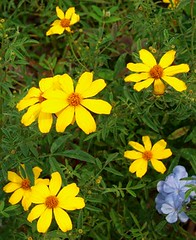
This intensely fragrant plant is Tagetes lemmonii with the common names lemon marigold, copper canyon daisy and mountain or lemmon's marigold. Of all the plants I've ever had in my garden, this one releases the most noticeable fragrance when barely touched or watered. Kind of a funky smell, some say a lemon scent; but the species name lemmonii comes from the botanical explorer J G Lemmon who discovered it in its native Arizona.
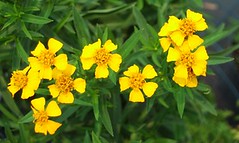
These flowers look similar to the ones above which is no surprise since this plant is the close relative Tagetes lucida. Commonly called Mexican mint marigold, it is used like tarragon in this area and so is also found sold under the common names Mexican, Texas, Spanish, tropical or winter tarragon.
True French tarragon (Artemisia dracunculus) is impossible to grow in Florida. It hates our hot humid summers and requires several months of dormancy brought on by winter freezing. If you live here in Florida and buy fresh tarragon in those little packages at the grocery store, you may have been using this tarragon all along. The fresh tarragon sold in our local grocery stores is nearly always this type since most of our local herbal produce is grown in south Florida.
Mexican tarragon is not as peppery as French tarragon and has more of an anise flavor, but it makes a great substitute. I add it to my homemade tartar sauce.
Sunday, July 01, 2007
Herbal Flowers #1

Lots of herb flowers in the garden now. The mints seem to be the most popular with the bees.

The fennel plants are full of flowers. Leaves (and flowers, too) have a licorace flavor, but it's the seeds that pack the big taste. If you buy fennel seeds in the store, you'll get the brown dried ones, but the less mature green ones are better tasting. If you want seeds for making more fennel plants though, you'll need to let them get to the brown dry stage.

Another herb with tasty seeds is cilantro. Fennel and cilantro are in the same plant family, Apiaceae, which has several other members with flavorful seeds: celery, dill, caraway, anise and cumin. The pretty little white flowers of cilantro are edible and have a sweet and very mild cilantro taste. The seeds of the cilantro plant, by the way, are given their own name (coriander).
Wednesday, April 11, 2007
2007 Seaside Herb Society Herbal Faire
On Saturday, March 24, I set up my booth at Seaside Herb Society’s Herbal Faire. This was my second year. They have a great location: the Riverbridge Meeting House and grounds in Ormond Beach, right on the Halifax River by the Granada Street bridge.

The main features of this location are the Riverbridge House, where the ladies serve the most delicious lunch, and the stone fountain ringed with trays of herbs for sale.
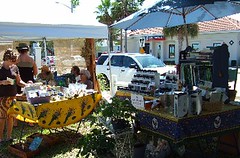
I brought a white wrought iron planter stand filled with scented geraniums, but outside of that I didn’t bring herbs to sell. The rest of my booth was filled with items from my store – our handmade herbal goods, herbal gadgets as well as herb books and herbal cookbooks. And I used my new Provence theme with colorful Provence tablecloths and some of my own "Provence" items: lavender bunches tied up with Provence fabric, lavender buds in a Provence fabric bag and little jars of Suzanne's Herbes de Provence.

There was an herbalist set up outside the meeting house dispensing herbal advice.
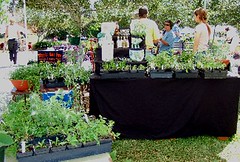
I always liked doing herb fairs when Maggie from Maggie’s Herbs in St Augustine showed up. She always had something out of the ordinary. Recently, Maggie’s Herbs was purchased by a young woman named Dora who stayed with this tradition. I picked up some coconut scented geraniums and a variegated mugwort. [Note on coconut scented geraniums: I read an article once that talked about how scented geraniums are named for fruits, nuts, etc but often don’t really smell like their namesakes. It gave coconut geranium as an example – one of the few that really does smell like its name!]
Dora is also a potter and had several of her things at the show including this birdbath:
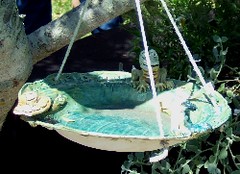
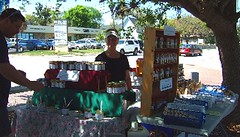
Holly from Herbal Creations also in St Augustine was there with her great herbal jellies and jams and herbal mixes. YUM!
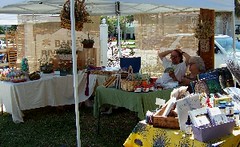
One of my neighbors had herbal crafts including a delicious blood orange marmalade.


I liked this booth with cute handmade birdhouses and beautiful painted stones.
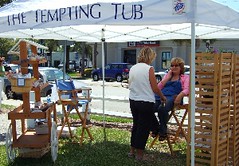
The ladies from the Tempting Tub were there again this year with their lovely body care products.
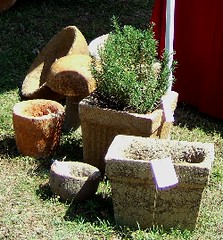
I’ve seen these hypertufa planters at several herb shows now. They’re the perfect containers for herbs – lightweight and earthy. I’m sorry I don’t have the artist’s name; I’m going to have to do better about getting names for my little blog entries here.

The main features of this location are the Riverbridge House, where the ladies serve the most delicious lunch, and the stone fountain ringed with trays of herbs for sale.

I brought a white wrought iron planter stand filled with scented geraniums, but outside of that I didn’t bring herbs to sell. The rest of my booth was filled with items from my store – our handmade herbal goods, herbal gadgets as well as herb books and herbal cookbooks. And I used my new Provence theme with colorful Provence tablecloths and some of my own "Provence" items: lavender bunches tied up with Provence fabric, lavender buds in a Provence fabric bag and little jars of Suzanne's Herbes de Provence.

There was an herbalist set up outside the meeting house dispensing herbal advice.

I always liked doing herb fairs when Maggie from Maggie’s Herbs in St Augustine showed up. She always had something out of the ordinary. Recently, Maggie’s Herbs was purchased by a young woman named Dora who stayed with this tradition. I picked up some coconut scented geraniums and a variegated mugwort. [Note on coconut scented geraniums: I read an article once that talked about how scented geraniums are named for fruits, nuts, etc but often don’t really smell like their namesakes. It gave coconut geranium as an example – one of the few that really does smell like its name!]
Dora is also a potter and had several of her things at the show including this birdbath:


Holly from Herbal Creations also in St Augustine was there with her great herbal jellies and jams and herbal mixes. YUM!

One of my neighbors had herbal crafts including a delicious blood orange marmalade.


I liked this booth with cute handmade birdhouses and beautiful painted stones.

The ladies from the Tempting Tub were there again this year with their lovely body care products.

I’ve seen these hypertufa planters at several herb shows now. They’re the perfect containers for herbs – lightweight and earthy. I’m sorry I don’t have the artist’s name; I’m going to have to do better about getting names for my little blog entries here.
Thursday, April 05, 2007
2007 Spring Fever in the Garden
On March 31 and April 1, I took my herbs and a few herbal books and other goodies to the 7th Annual Spring Fever in the Garden in historic downtown Winter Garden. This garden show was put on by the Bloom N Grow Garden Society whose members could not have been more helpful and accommodating. They also attracted a good crowd, all of which meant I not only had a good show saleswise, but had fun doing the show, too. They have a website for the Spring Fever which is really spectacular.

I love a good historic downtown area and Winter Garden has a very nice one. Lots of little restaurants, including the Moon Cricket Grille across from my booth with an owner who traded me a lunch for some herbs.
The show took place, appropriately enough, on Plant Street, a brick street with

a beautiful island down the middle and places like

the Garden Theater which welcomed the show.
I was fortunate to be near one of the performers, singer Grant Livingston, who kept me entertained both days with his humorous songs.
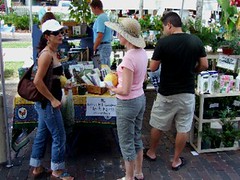


My booth was filled mostly with herbs and I tried to bring a good selection of the favorites that everyone wants along with a few unusual things to delight those herb gardeners seeking something different. The biggest hit seemed to be the tray of nasturtiums.
I also brought a few herb books, some herbal gadgets (like herb keepers and mortars and pestles), a few of my Provence crafts and some great vintage wooden herb carriers.

Of course, no garden show would be complete without orchids

or roses and there were many other plant booths, too, although I wasn't able to get away from my booth for very long to take pictures of them all.
Being a potter myself, I was especially interested in several booths that had ceramics:
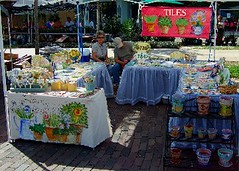
I've been designing several plant labels including some with herb names in French to coincide with my Herbes de Provence store theme. This artist had several very cute ceramic labels (some with French herb names!) although they're much different than the ones I'm planning. I even made a trade here.
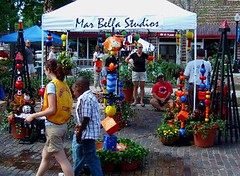
This artist makes large funky brightly-colored ceramic sculptures for the garden including totem-like stakes and a working fountain.

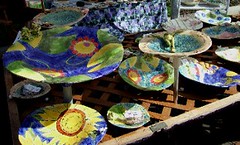
I love this potter's great birdbaths with painted and three-dimensional flowers, turtles and frogs.
Really, the ceramic stuff was terrific and would brighten up any garden.
Also brightening up a garden would be any of the adirondak chairs that were up for (silent) auction:


including my favorite:


I love a good historic downtown area and Winter Garden has a very nice one. Lots of little restaurants, including the Moon Cricket Grille across from my booth with an owner who traded me a lunch for some herbs.
The show took place, appropriately enough, on Plant Street, a brick street with

a beautiful island down the middle and places like

the Garden Theater which welcomed the show.
I was fortunate to be near one of the performers, singer Grant Livingston, who kept me entertained both days with his humorous songs.



My booth was filled mostly with herbs and I tried to bring a good selection of the favorites that everyone wants along with a few unusual things to delight those herb gardeners seeking something different. The biggest hit seemed to be the tray of nasturtiums.
I also brought a few herb books, some herbal gadgets (like herb keepers and mortars and pestles), a few of my Provence crafts and some great vintage wooden herb carriers.

Of course, no garden show would be complete without orchids

or roses and there were many other plant booths, too, although I wasn't able to get away from my booth for very long to take pictures of them all.
Being a potter myself, I was especially interested in several booths that had ceramics:

I've been designing several plant labels including some with herb names in French to coincide with my Herbes de Provence store theme. This artist had several very cute ceramic labels (some with French herb names!) although they're much different than the ones I'm planning. I even made a trade here.

This artist makes large funky brightly-colored ceramic sculptures for the garden including totem-like stakes and a working fountain.


I love this potter's great birdbaths with painted and three-dimensional flowers, turtles and frogs.
Really, the ceramic stuff was terrific and would brighten up any garden.
Also brightening up a garden would be any of the adirondak chairs that were up for (silent) auction:


including my favorite:

Subscribe to:
Posts (Atom)
